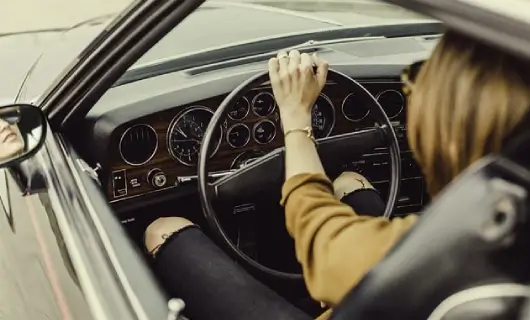As is true across the country, Texas places an age limit on who can obtain a driver license and operate a vehicle on its streets. In general, teen drivers must be at least 18 years old in order to receive a driver’s license outright.
Most Texas drivers agree with this safety regulation. The belief is that waiting until someone is mature enough to handle the responsibility of driving privileges is best for all.
However, exceptions exist. Some young people deserve a chance to prove their abilities to receive a driver license earlier than usual. Life circumstances and problems are no respecters of age.
A 15-year-old can find themselves the virtual head of a household and need a Texas drivers license, for example. To make things easier for these minors, the Texas Department of Public Safety created the Texas Hardship License. This includes situations such as a death-related emergency, where the death of a family member creates significant challenges and the need for mobility.
The process for getting such a minor restricted driver license is not as difficult as one may initially believe. Following is the information needed to apply.

What is a hardship license?
The Minor Restricted Driver License (MRDL), also known as a minor’s restricted driver license, is the official name for what most call the Texas “hardship” license. This permit allows a minor, of at least age 15, to practice defensive driving without the presence of an adult, if doing so has been proven to be a necessity. It is a driver license with restrictions.
Purpose of a Hardship License
- Handles urgent needs: Gives minors a way to legally drive when facing tough situations, like family emergencies or financial hardship.
- Offers a legal path for minors: Allows teens, typically aged 15 or older, to drive under strict guidelines when necessary.
- Helps with essential responsibilities: Enables minors to handle important duties such as getting to work, school, or taking care of family members who need medical attention.
Benefits of a Hardship License
- Gives minors mobility: Provides teens the ability to drive for crucial reasons, like attending vocational programs, working, or helping family members in need.
- Eases family challenges: Relieves some pressure on families dealing with difficult situations by allowing minors to help out through driving.
- Promotes responsibility: Allows young drivers to take on more responsibility in a controlled way, helping them become more independent while still following strict rules.
- Keeps it legal: Ensures that minors who truly need to drive are doing so legally, which reduces the risks of unlicensed driving and protects everyone on the road.
Texas Hardship License Eligibility
To be eligible for a hardship license in Texas, the teen must meet the Texas hardship license eligibility criteria by falling into one or more of these categories.
- Without the teen being able to drive, the family would suffer from an unusual economic hardship that prevents it from enjoying the basic necessities of life.
- There is an ill family member who the teen must drive to receive medical care and other life needs.
- The teen is a student in a certified vocational education program.
- The teen must temporarily perform head of household duties; for example, following the death of a family member.
Before the state will grant an unusual economic hardship license and honor a teen driving privileges, the applicant has to complete a Texas motorcycle or driver education course.
Proving Hardship
The authorities will need some evidence of actual hardship before granting this specialized driver license. Earnings statements demonstrating a financial burden that only the minor can solve can help. Proof of gainful employment and a salary that can provide significant support for the family is another crucial piece of evidence.
Sworn or on-person statements by employers, school officials and social workers are other possible means to persuade the state of the need for a hardship license.
Texas Hardship License Application Process
To apply, take all of the following to a local driver license office:
- All identifying information required of regular full operator license applications as stated here: regular licensing requirements.
- Parent or guardian.
- Texas hardship license application.
- Signed form verifying completion of Texas driver education program.
- Impact Texas Teen Drivers (ITTD) form.
Always remember that a parent or guardian must sign the application form along with the minor applicant. Afterwards, submit the completed application in person with the parent or guardian at the nearest state motor vehicle office. In cases where the teen does not have a parent or guardian, a county judge or even employer can stand in their behalf. So, how old do you have to be to get a driver’s license in Texas?
15 years old is the youngest age in which a Texas license office wil l grant teen drivers a hardship license. However, it is possible to apply for early enrollment in the required Texas driver training class when only 14 years old.
Cost
The fees are standard, ranging from $16 to $25.
Driving Restrictions
Teens with a hardship license cannot partake in defensive driving whenever and wherever they want like they could with a regular Texas driver license. Since the state issues these permits based on claimed necessity, the minor must only use this restricted license when performing duties related to the specified familial or individual hardship.
For example, someone granted a hardship license in Texas to attend vocational school cannot be legally on the road alone heading to a party. Also, if living conditions change, then the teen driver must not use the hardship licenses or they can face legal penalties.
Frequently Asked Questions
What is a Texas Hardship License, and how does it work?
A Texas Hardship License, also known as a Minor Restricted Driver License (MRDL), allows teens as young as 15 to legally drive under certain conditions. This special permit is issued to minors facing specific hardships, caring for an ill family member, or attending a vocational school. It’s designed for situations where driving is a necessity, and it allows limited driving privileges that differ from a full driver’s license.
What qualifies you for a hardship license in Texas?
To qualify for a hardship license in Texas, you must be at least 15 years old and demonstrate a specific need for driving. There are several qualifying hardships outlined in the Texas Transportation Code, including:
- Economic hardship: When a minor’s ability to drive is necessary for the family to meet basic necessities.
- Medical reasons: If the minor must drive to care for an ill family member.
- Vocational education: The need to drive to and from a vocational school.
- Other family-related hardships: Such as when the minor temporarily assumes head-of-household duties due to a family crisis.
How long does a hardship license last, and when does it expire?
A Texas hardship license is temporary and expires either when the minor turns 18 or when the hardship no longer exists. The minor can later apply for a regular driver’s license by meeting the necessary requirements, such as passing the driving skills test and completing all required operator license applications.
What are the reasons to get a hardship license in Texas?
In Texas, individuals may qualify for a hardship license for several reasons, including unusual economic hardship that impacts the family’s basic needs, the need to care for an ill family member, a family crisis requiring the minor to take on household responsibilities, or enrollment in a vocational education program that necessitates driving.
Can a Texas hardship license be used for any type of driving?
No, a Texas hardship license is only valid for specific driving circumstances related to the hardship. The minor can only drive to work or for tasks tied to that hardship. Violating these conditions, such as driving to a social event, can result in penalties or suspension of driving privileges.
What role does attending a vocational school play in hardship license eligibility?
Attending a certified vocational school is one of the qualifying hardships under Texas law. Minors who need to drive to and from vocational classes can apply for a hardship license by providing proof of enrollment. This can help them meet their academic requirements when no other transportation is available, as outlined in the Texas Administrative Code.
What is the process for proving financial hardship for a hardship license?
To prove financial hardship, the applicant must provide documentation showing that the minor’s ability to drive is essential for their family’s basic necessities. This can include earnings statements, proof of employment, or signed statements from employers. Evidence of a qualifying hardship, such as the inability to use public transportation or financial responsibilities within the household, will help strengthen the application.

 Live Chat
Live Chat







